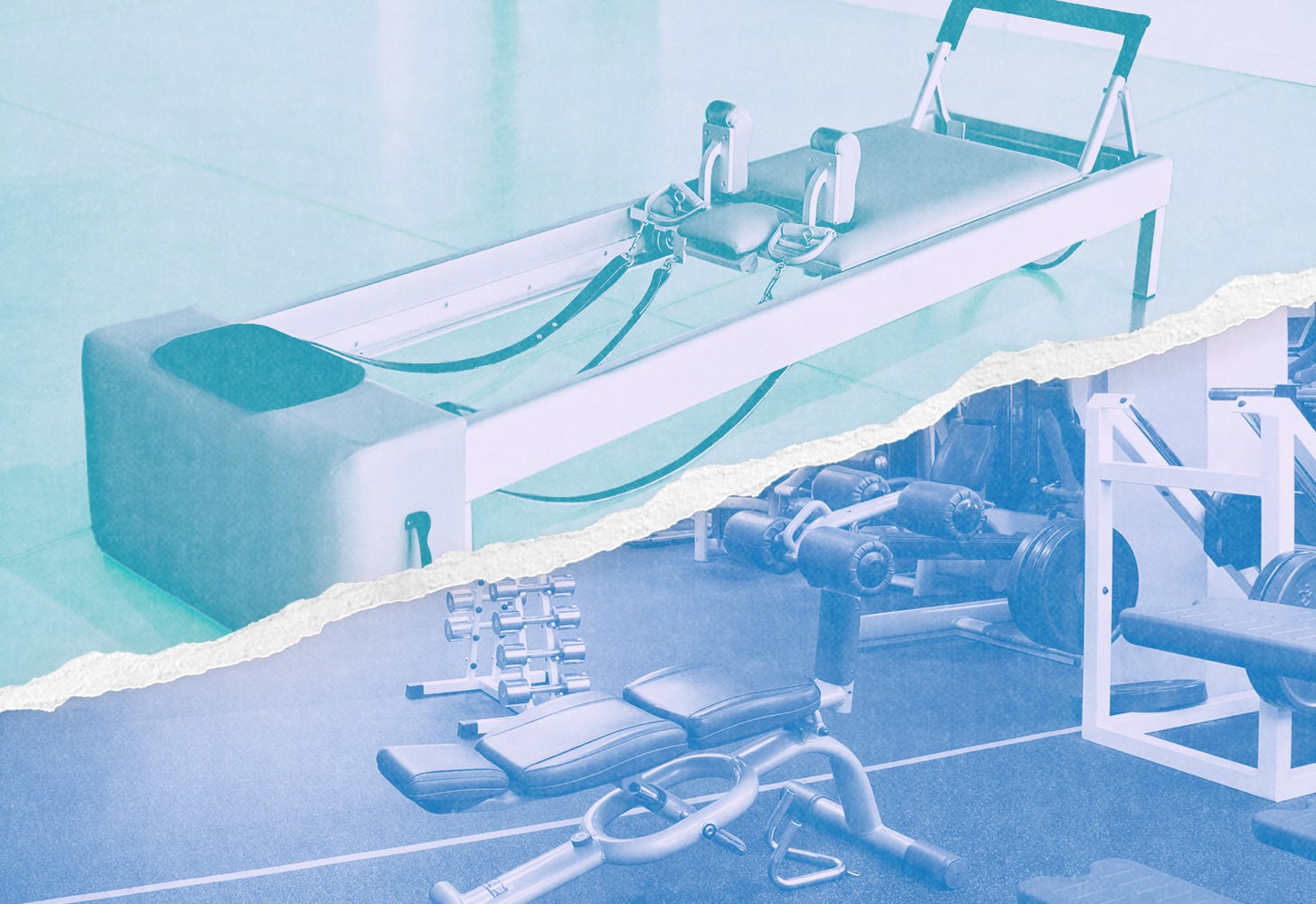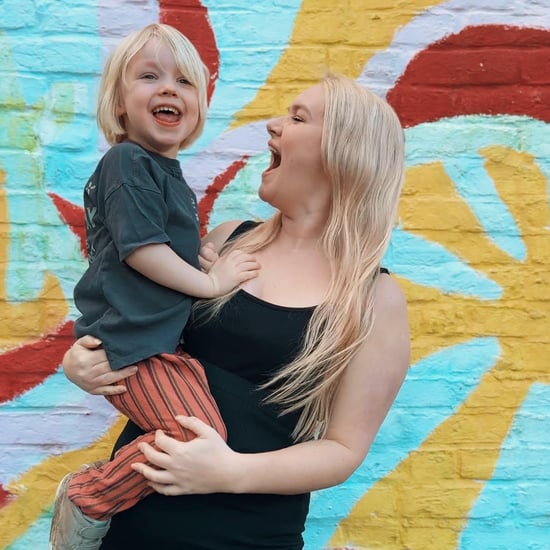The Pilates Body vs. Weightlifting Body Debate Is Harmful
Why We Need to Stop Comparing "Gym Bodies" and "Pilates Bodies"

In one TikTok video, footage of a thin woman in a one-piece bathing suit transitions to a video of the same woman, now proudly displaying her buns of steel in a thongkini: "POV: you traded Pilates for real weight training," the voiceover and on-screen caption says. Implied here, of course, is that this creator "transformed" her body by switching up her workouts.
Videos with hashtags that pit Pilates against weightlifting, specifically, have millions of views of TikTok, with members of both camps debating not just the pros and cons of these exercises, but the bodies they "got" from doing them. But this comparison isn't a solution to finding the perfect workout for your perfect body: it's a trap. When you start comparing your wellness journey, body type, workout schedule, or diet to that of others, you're never going to feel like you're winning — despite all the hard work you've put in.
Luckily, for as many of these videos as there are on TikTok, an equal number of creators are sharing the truth: which is that you don't need to choose between the two modalities and that comparing them and their "results" can be harmful for both your physical and mental health.
Where Did the Gym Body vs. Pilates Body Debate Start?
Pilates has been around since the 1920s, but it's seen a resurgence in popularity in recent years, thanks in large part to social media, says certified Pilates instructor Ashlea McKee.
During the COVID-19 pandemic, many people swapped their rigorous, high-intensity sweat sessions for a gentler, more mindful approach to exercise, says Grace Taylor, DPT. People were looking for workouts that easily translated to a home-gym setting (read: a mat in the corner of your bedroom) and offered a break from intense workouts during a time of high stress. Endorsements from celebs like Kylie Jenner and Kerry Washington, who swear by Pilates — "Pilates has allowed me to be focussed on my appearance and my health in ways that are not abusive or critical," Washington told Women's Health — further fuelled the movement, and soon the "Pilates princess" aesthetic was filling social feeds with snaps of exercisers posing on fancy reformer machines in pastel matching sets.
Meanwhile, over on GymTok, the weightlifting or gym aesthetic embodies the opposite vibe. Rather than pastels and bohemian bare feet, the gym content has a decidedly more heavy metal vibe: literally — it's filled with sweat, steel, and iron.
Wherever there is talk of workouts, there is inevitably talk of bodies. Here, too, the stereotypes associated with Pilates and weightlifting appear at odds: many Pilates studios and instructors promise their clients that the modality will cultivate a "long, lean body," while weightlifters are assumed to be ripped, bulky bodybuilders.
Neither of these tropes reflect reality. And therefore, pitting these body types against each other not only perpetuates unrealistic stereotypes, it reinforces the false idea that there's any right way to have a body.
Why Pilates Body vs. Gym Body Is a Harmful Mindset
This entire debate is based on a false premise: that any particular workout can make your body look a particular way. Different people need different workouts to best suit their individual needs and goals, McKee says, and everyone's body will respond differently to those routines.
This entire debate is based on a false premise: that any particular workout can make your body look a particular way.
What's more, while there's nothing wrong with wanting to feel stronger or leaner, focusing exclusively on appearances can foster an unhealthy relationship with exercise and your body, says Laura Cohen, creator of The No Weigh Way and lead family mentor at Equip, a virtual service for eating disorder treatment.
"I'm a very strong advocate of joyful movement, which means decoupling exercise and movement from what physical changes may — or may not — occur, and choosing movement based on what feels good to you, both physically and mentally," says Cohen. "Most important is finding what type of movement brings you joy."
Finding and creating an exercise routine that you love is also one of the best ways to stick with it and reap all the benefits of exercise.
"Any body will benefit from movement, and especially movement that makes them feel their best, inside and out. Because when you find something that makes you feel your best, you will look forward to it, stay consistent, and implement it seamlessly into your life," McKee says.
Zooming out, the Pilates vs. weightlifting debate is harmful beyond your personal exercise routine. At its core, this is a conversation about how women's bodies should look, which reinforces the premise — put forth by diet culture — that one body type is "better" than another.
Why You Have Room For Both Workout Types in Your Routine
Pitting Pilates bodies against gym bodies "creates a binary of right or wrong, good or bad, and that's not the way that exercise works," says movement educator and author Trina Altman.
Pitting Pilates bodies against gym bodies "creates a binary of right or wrong, good or bad, and that's not the way that exercise works."
In fact, Pilates and strength training complement each other, Altman says. "Pilates can improve your mobility and body awareness, which can make it easier to perform strength exercises with better technique. Alternatively, strength training can make more advanced Pilates exercises feel easier."
The two complement each other because each practice works a different type of muscle. You have both stabilising muscles and moving muscles in your body. "Moving muscles are what they sound like: get you from point A to point B and allow you to do things like open a door, lift a backpack, get dressed, and play outside with your kids," says Altman. "Your stability muscles work on a smaller scale, and work to keep you upright with proper alignment." More traditional strength training focuses on those moving muscles, while Pilates is all about the stabilising muscles — since you need both to function well, dedicating your time to only one of these practices is doing you a disservice.
"Incorporating both into your routine gives you complementary strength and balance to safely participate in a wide range of activities," Taylor says.
In general, sticking to only one type of activity, whether it's Pilates, weight training, or something else, can really limit you, Taylor adds. Having a variety of exercise types in your routine helps to minimise plateaus, prevents boredom, supports different goals (such as balance, flexibility, strength, endurance, etc.), and affords you some flexibility when an injury or busy schedule gets in the way of the gym. When you diversify your fitness rather than sticking to just one thing, it's better for both your body and mind.
"There's no moral value of practicing one or both of these activities," says Cohen. Stereotypes about what you're supposed to want, how you're supposed to look, or the idea that a certain exercise can make your body look a certain way are only noise that's going to prevent you from truly listening to your body's own exercise needs.






